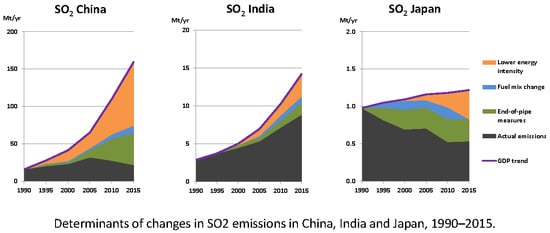Decomposing Air Pollutant Emissions in Asia: Determinants and Projections
Abstract
:1. Introduction
2. Materials and Methods
2.1. Data Sources
2.2. Socioeconomic Drivers
2.3. Policy Context
2.4. Computation Method
- (a)
- Temporal change in energy intensity, that is, the Energy consumed per unit of economic output (GDP), which determines the size of energy demand, structure of energy services, and reflects differences in socioeconomic structures, as well as in behavioral patterns. Energy intensity is complemented by the impacts of efficiency improvements of the energy system (Δη), in other words, the efficiency at which primary energy is converted into secondary and final energy.
- (b)
- The evolution of the fuel mix of different energy forms affects emission intensities, comprising inter-fossil-fuel switch and changes in the fraction of non-fossil fuels in energy supply. Substitution of traditional/combustible fuels by electricity and district heating contributes to this mitigation component on the demand side of the energy system.
- (c)
- The changes in aggregated emission factors over time—or the amount of pollutants emitted per unit of energy—which typically follow the implementation of end-of-pipe measures and fuel quality standards. The resulting emission coefficient reflects the removal efficiency (eff) of a given abatement measure adopted at a specific rate (ΔX).
3. Results and Discussion
3.1. Decomposition Analysis
3.1.1. China
3.1.2. India
3.1.3. Japan
3.2. Reassessment of Air Pollutant Scenarios for Asia
4. Conclusions
Author Contributions
Acknowledgments
Conflicts of Interest
References
- WHO. Ambient Air Pollution: A Global Assessment of Exposure and Burden of Disease; World Health Organization (WHO): Geneva, Switzerland, 2016. [Google Scholar]
- IEA. World Energy Outlook Special Report: Energy and Air Pollution; International Energy Agency (IEA): Paris, France, 2016. [Google Scholar]
- Emberson, L.D.; Ashmore, M.R.; Murray, F.; Kuylenstierna, J.C.I.; Percy, K.E.; Izuta, T.; Zheng, Y.; Shimizu, H.; Sheu, B.H.; Liu, C.P.; et al. Impacts of Air Pollutants on Vegetation in Developing Countries. Water Air Soil Pollut. 2001, 130, 107–118. [Google Scholar] [CrossRef]
- Chan, C.K.; Yao, X. Air pollution in mega cities in China. Atmos. Environ. 2008, 42, 1–42. [Google Scholar] [CrossRef]
- Cohen, A.J.; Brauer, M.; Burnett, R.; Anderson, H.R.; Frostad, J.; Estep, K.; Balakrishnan, K.; Brunekreef, B.; Dandona, L.; Dandona, R.; et al. Estimates and 25-year trends of the global burden of disease attributable to ambient air pollution: An analysis of data from the Global Burden of Diseases Study 2015. Lancet 2017, 389, 1907–1918. [Google Scholar] [CrossRef]
- IEA. World Energy Outlook 2017; International Energy Agency: Paris, France, 2017. [Google Scholar]
- Vrontisi, Z.; Abrell, J.; Neuwahl, F.; Saveyn, B.; Wagner, F. Economic impacts of EU clean air policies assessed in a CGE framework. Environ. Sci. Policy 2016, 55, 54–64. [Google Scholar] [CrossRef] [Green Version]
- Matus, K.; Yang, T.; Paltsev, S.; Reilly, J.; Nam, K.-M. Toward integrated assessment of environmental change: Air pollution health effects in the USA. Clim. Chang. 2008, 88, 59–92. [Google Scholar] [CrossRef]
- Charfeddine, L.; Yousef Al-Malk, A.; Al Korbi, K. Is it possible to improve environmental quality without reducing economic growth: Evidence from the Qatar economy. Renew. Sustain. Energy Rev. 2018, 82, 25–39. [Google Scholar] [CrossRef]
- Wakamatsu, S.; Morikawa, T.; Ito, A. Air pollution trends in Japan between 1970 and 2012 and impact of urban air pollution countermeasures. Asian J. Atmos. Environ. 2013, 7, 177–190. [Google Scholar] [CrossRef]
- Amann, M.; Cofala, J. Scenarios of future acidification in Asia: Exploratory calculations. In RAINS-Asia Technical Report: The Development of An Integrated Model for Sulfur Deposition; World Bank, Asia Technical Group: Washington, DC, USA, 1995. [Google Scholar]
- Downing, R.J.; Ramankutty, R.; Shah, J.J. RAINS-ASIA: An Assessment Model for Acid Deposition in Asia; Directions in Development, No. 17108; The World Bank: Washington, DC, USA, 1997. [Google Scholar]
- Foell, W.; Green, C.; Amann, M.; Bhattacharya, S.; Carmichael, G.; Chadwick, M.; Cinderby, S.; Haugland, T.; Hettelingh, J.-P.; Hordijk, L.; et al. Energy use, emissions, and air pollution reduction strategies in Asia. Water Air Soil Pollut. 1995, 85, 2277–2282. [Google Scholar] [CrossRef]
- Shah, J.; Nagpal, T.; Johnson, T.; Amann, M.; Carmichael, G.; Foell, W.; Green, C.; Hettelingh, J.-P.; Hordijk, L.; Li, J.; et al. Integrated analysis for acid rain in Asia: Policy implications and results of RAINS-ASIA model. Annu. Rev. Energy Environ. 2000, 25, 339–375. [Google Scholar] [CrossRef]
- IEA. IEA World Energy Statistics and Balances (Database); International Energy Agency (IEA): Paris, France, 2017; Available online: http://dx.doi.org/10.1787/enestats-data-en (accessed on 1 December 2017).
- GAINS. Greenhouse Gas—Air Pollution Interactions and Synergies—Model Database; International Institute for Applied Systems Analysis (IIASA): Laxenburg, Austria, 2017; Available online: http://gains.iiasa.ac.at (accessed on 1 December 2017).
- Stern, D.I. The environmental Kuznets curve after 25 years. J. Bioecon. 2017, 19, 7–28. [Google Scholar] [CrossRef]
- Amann, M.; Klimont, Z.; Wagner, F. Regional and Global Emissions of Air Pollutants: Recent Trends and Future Scenarios. Annu. Rev. Environ. Resour. 2013, 38, 31–55. [Google Scholar] [CrossRef]
- De Bruyn, S.M.; van den Bergh, J.C.J.M.; Opschoor, J.B. Economic growth and emissions: Reconsidering the empirical basis of environmental Kuznets curves. Ecol. Econ. 1998, 25, 161–175. [Google Scholar] [CrossRef]
- Henneman, L.R.; Chang, H.H.; Liao, K.-J.; Lavoué, D.; Mulholland, J.A.; Russell, A.G. Accountability assessment of regulatory impacts on ozone and PM2.5 concentrations using statistical and deterministic pollutant sensitivities. Air Qual. Atmos. Health 2017, 10, 695–711. [Google Scholar] [CrossRef]
- Kawamoto, T.; Pham, T.-T.-P.; Matsuda, T.; Oyama, T.; Tanaka, M.; Yu, H.-S.; Uchiyama, I. Historical review on development of environmental quality standards and guideline values for air pollutants in Japan. Int. J. Hyg. Environ. Health 2011, 214, 296–304. [Google Scholar] [CrossRef] [PubMed]
- Zhao, B.; Su, Y.; He, S.; Zhong, M.; Cui, G. Evolution and comparative assessment of ambient air quality standards in China. J. Integr. Environ. Sci. 2016, 13, 85–102. [Google Scholar] [CrossRef]
- Jin, Y.; Andersson, H.; Zhang, S. Air Pollution Control Policies in China: A Retrospective and Prospects. Int. J. Environ. Res. Public Health 2016, 13, 1219. [Google Scholar] [CrossRef] [PubMed]
- Hashimoto, M. Chapter 1 History of Air Pollution Control in Japan. In Studies in Environmental Science, How to Conquer Air Pollution a Japanese Experience; Nishimura, H., Ed.; Elsevier: New York, NY, USA, 1989; pp. 1–93. [Google Scholar] [CrossRef]
- IEA CCC. Emission Standards by Country–Online Database; IEA Clean Coal Centre: London, UK, 2017; Available online: http://www.iea-coal.org.uk/site/2010/database-section/emission-standards (accessed on 1 December 2017).
- McConville, A. Emission Standards Handbook; IEA Clean Research–The Clean Coal Centre: London, UK, 1997. [Google Scholar]
- DieselNet. Emission Standards—Summary of World’s Engine and Vehicle Emission Standards; DieselNet—Online Information Service; Ecopoint Inc.: Mississauga, ON, Canada, 2017; Available online: https://www.dieselnet.com/standards/ (accessed on 1 December 2017).
- MoE Japan. Japan’s Regulations and Environmental Law; Ministry of Environment, Government of Japan: Tokio, Japan, 2017. Available online: http://www.env.go.jp/en/coop/pollution.html (accessed on 1 December 2017).
- Hoekstra, R.; van den Bergh, J.C.J.M. Comparing structural and index decomposition analysis. Energy Econ. 2003, 25, 39–64. [Google Scholar] [CrossRef]
- Rafaj, P.; Amann, M.; Siri, J.; Wuester, H. Changes in European greenhouse gas and air pollutant emissions 1960–2010: Decomposition of determining factors. Clim. Chang. 2014, 124, 477–504. [Google Scholar] [CrossRef]
- Åström, S.; Yaramenka, K.; Mawdsley, I.; Danielsson, H.; Grennfelt, P.; Gerner, A.; Ekvall, T.; Ahlgren, E.O. The impact of Swedish SO2 policy instruments on SO2 emissions 1990–2012. Environ. Sci. Policy 2017, 77, 32–39. [Google Scholar] [CrossRef]
- Rafaj, P.; Amann, M.; Siri, J.G. Factorization of air pollutant emissions: Projections versus observed trends in Europe. Sci. Total Environ. 2014, 494–495, 272–282. [Google Scholar] [CrossRef] [PubMed]
- Mao, X.; Zhou, J.; Corsetti, G. How Well Have China’s Recent Five-Year Plans Been Implemented for Energy Conservation and Air Pollution Control? Environ. Sci. Technol. 2014, 48, 10036–10044. [Google Scholar] [CrossRef] [PubMed]
- Tong, Z.; Chen, Y.; Malkawi, A.; Liu, Z.; Freeman, R.B. Energy saving potential of natural ventilation in China: The impact of ambient air pollution. Appl. Energy 2016, 179, 660–668. [Google Scholar] [CrossRef]
- Feng, L.; Liao, W. Legislation, plans, and policies for prevention and control of air pollution in China: Achievements, challenges, and improvements. J. Clean. Prod. 2016, 112, 1549–1558. [Google Scholar] [CrossRef]
- Fu, H.; Chen, J. Formation, features and controlling strategies of severe haze-fog pollutions in China. Sci. Total Environ. 2017, 578, 121–138. [Google Scholar] [CrossRef] [PubMed]
- Gao, J.; Woodward, A.; Vardoulakis, S.; Kovats, S.; Wilkinson, P.; Li, L.; Xu, L.; Li, J.; Yang, J.; Li, J.; et al. Haze, public health and mitigation measures in China: A review of the current evidence for further policy response. Sci. Total Environ. 2017, 578, 148–157. [Google Scholar] [CrossRef] [PubMed]
- Xu, S.; Zhang, W.; Li, Q.; Zhao, B.; Wang, S.; Long, R. Decomposition Analysis of the Factors that Influence Energy Related Air Pollutant Emission Changes in China Using the SDA Method. Sustainability 2017, 9, 1742. [Google Scholar] [CrossRef]
- Fujii, H.; Managi, S.; Kaneko, S. Decomposition analysis of air pollution abatement in China: Empirical study for ten industrial sectors from 1998 to 2009. J. Clean. Prod. 2013, 59, 22–31. [Google Scholar] [CrossRef]
- Liu, Q.; Wang, Q. Pathways to SO2 emissions reduction in China for 1995–2010: Based on decomposition analysis. Environ. Sci. Policy 2013, 33, 405–415. [Google Scholar] [CrossRef]
- Lipscy, P.Y.; Schipper, L. Energy efficiency in the Japanese transport sector. Energy Policy 2013, 56, 248–258. [Google Scholar] [CrossRef]
- Klimont, Z.; Cofala, J.; Schöpp, W.; Amann, M.; Streets, D.G.; Ichikawa, Y.; Fujita, S. Projections of SO2, NOx, NH3 and VOC emissions in East Asia up to 2030. Water Air Soil Pollut. 2001, 130, 193–198. [Google Scholar] [CrossRef]
- Klimont, Z.; Cofala, J.; Xing, J.; Wei, W.; Zhang, C.; Wang, S.; Kejun, J.; Bhandari, P.; Mathur, R.; Purohit, P.; et al. Projections of SO2, NOx, and carbonaceous aerosols emissions in Asia. Tellus B 2009, 61, 602–617. [Google Scholar] [CrossRef] [Green Version]
- Wang, S.X.; Zhao, B.; Cai, S.Y.; Klimont, Z.; Nielsen, C.P.; Morikawa, T.; Woo, J.H.; Kim, Y.; Fu, X.; Xu, J.Y.; et al. Emission trends and mitigation options for air pollutants in East Asia. Atmos. Chem. Phys. 2014, 14, 6571–6603. [Google Scholar] [CrossRef] [Green Version]
- Stohl, A.; Aamaas, B.; Amann, M.; Baker, L.H.; Bellouin, N.; Berntsen, T.K.; Boucher, O.; Cherian, R.; Collins, W.; Daskalakis, N.; et al. Evaluating the climate and air quality impacts of short-lived pollutants. Atmos. Chem. Phys. 2015, 15, 10529–10566. [Google Scholar] [CrossRef] [Green Version]
- Landrigan, P.J.; Fuller, R.; Acosta, N.J.R.; Adeyi, O.; Arnold, R.; Basu, N.; Baldé, A.B.; Bertollini, R.; Bose-O’Reilly, S.; Boufford, J.I.; et al. The Lancet Commission on pollution and health. Lancet 2017, 391, 462–512. [Google Scholar] [CrossRef]
- Csereklyei, Z.; Stern, D.I. Global energy use: Decoupling or convergence? Energy Econ. 2015, 51, 633–641. [Google Scholar] [CrossRef]
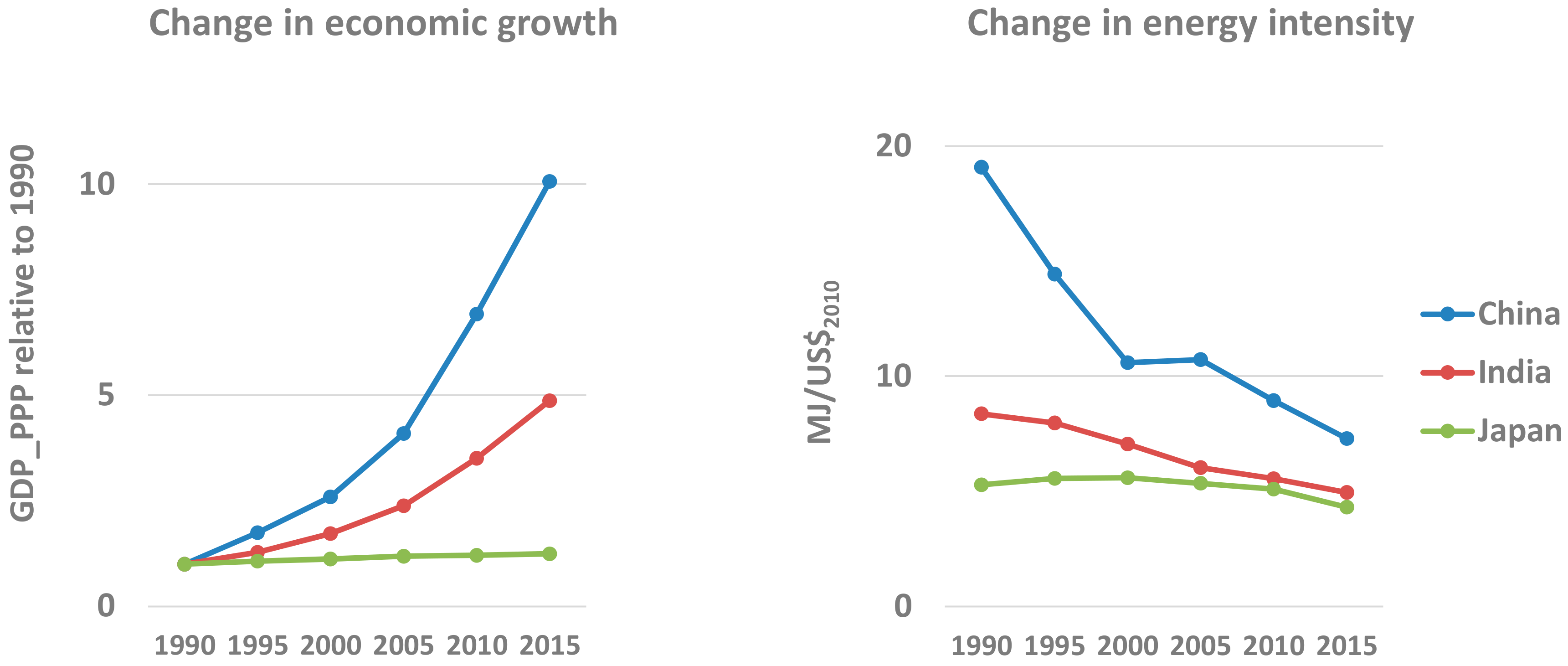
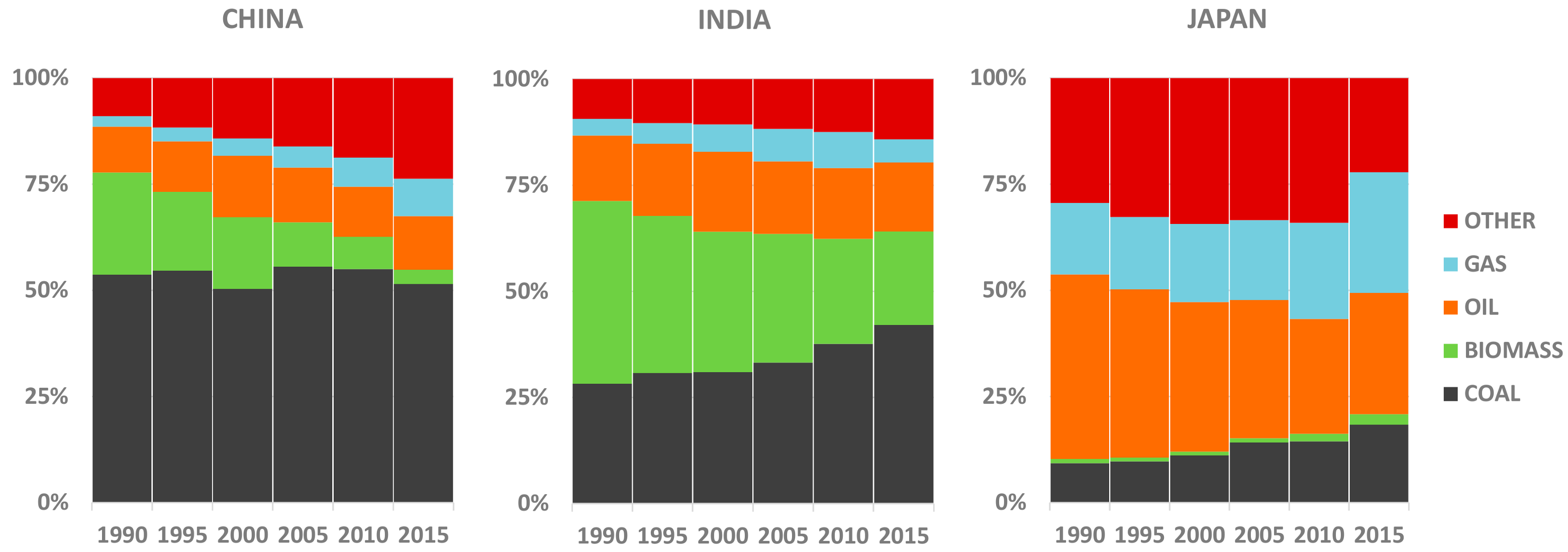

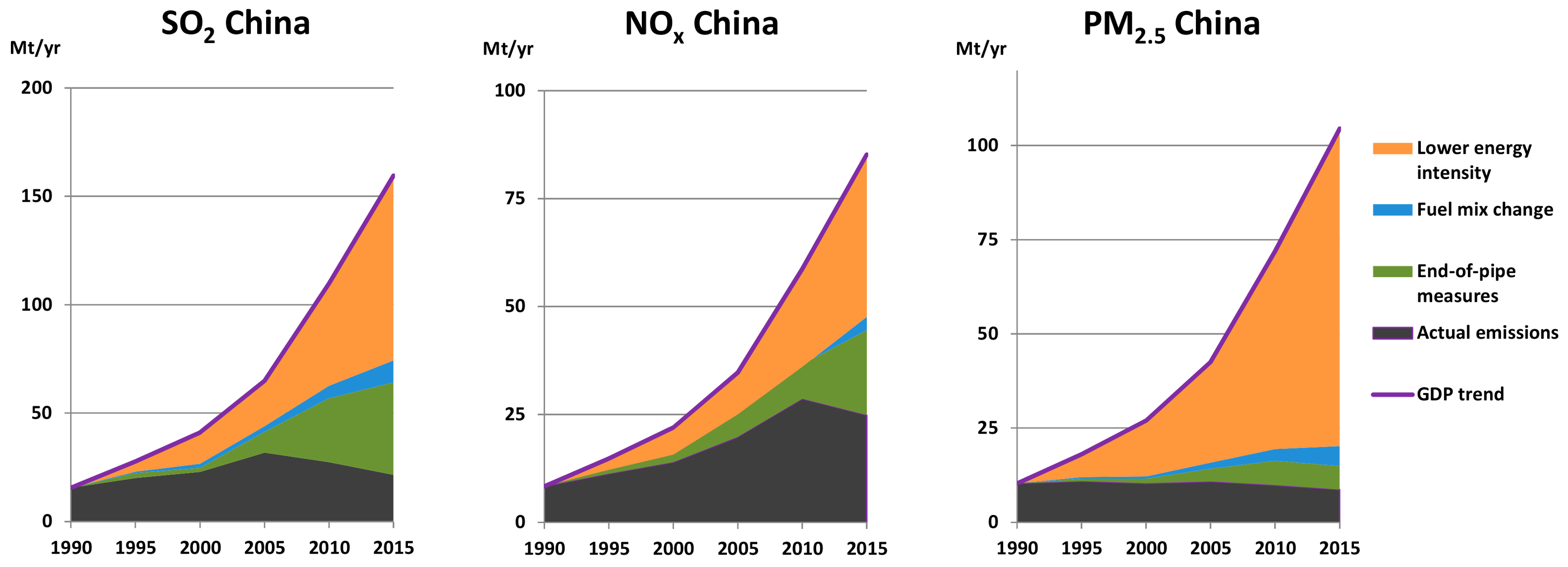
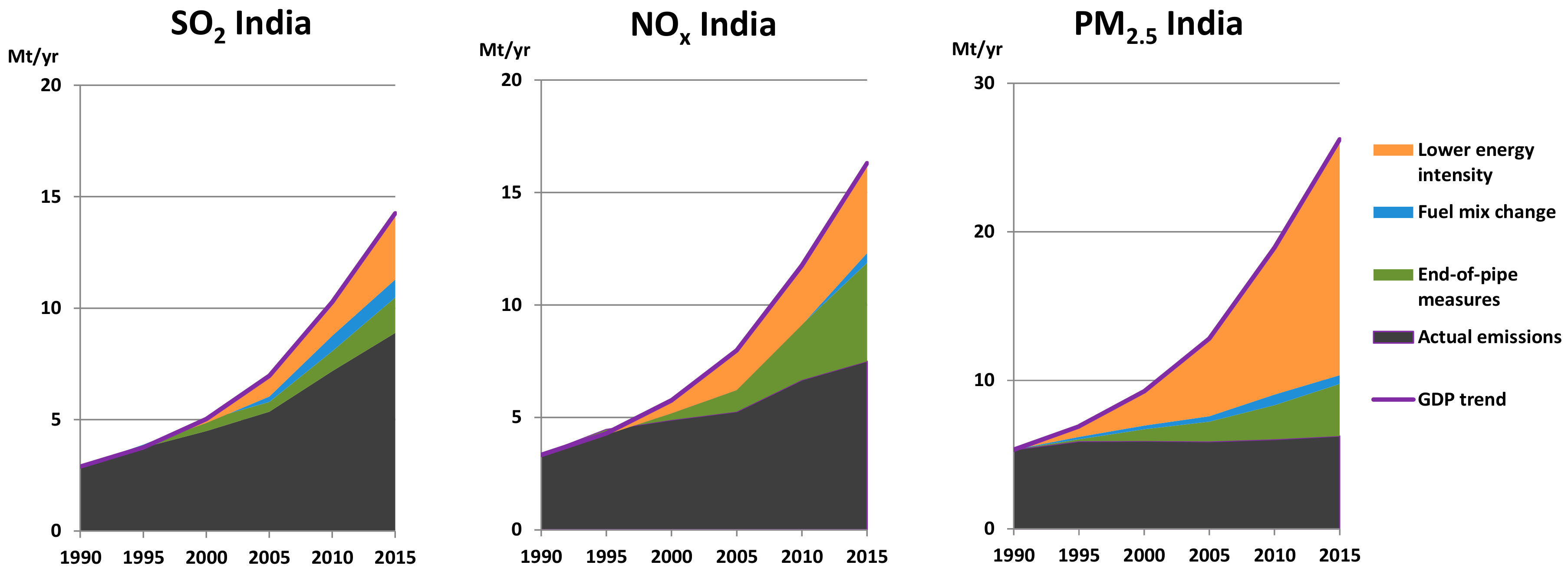

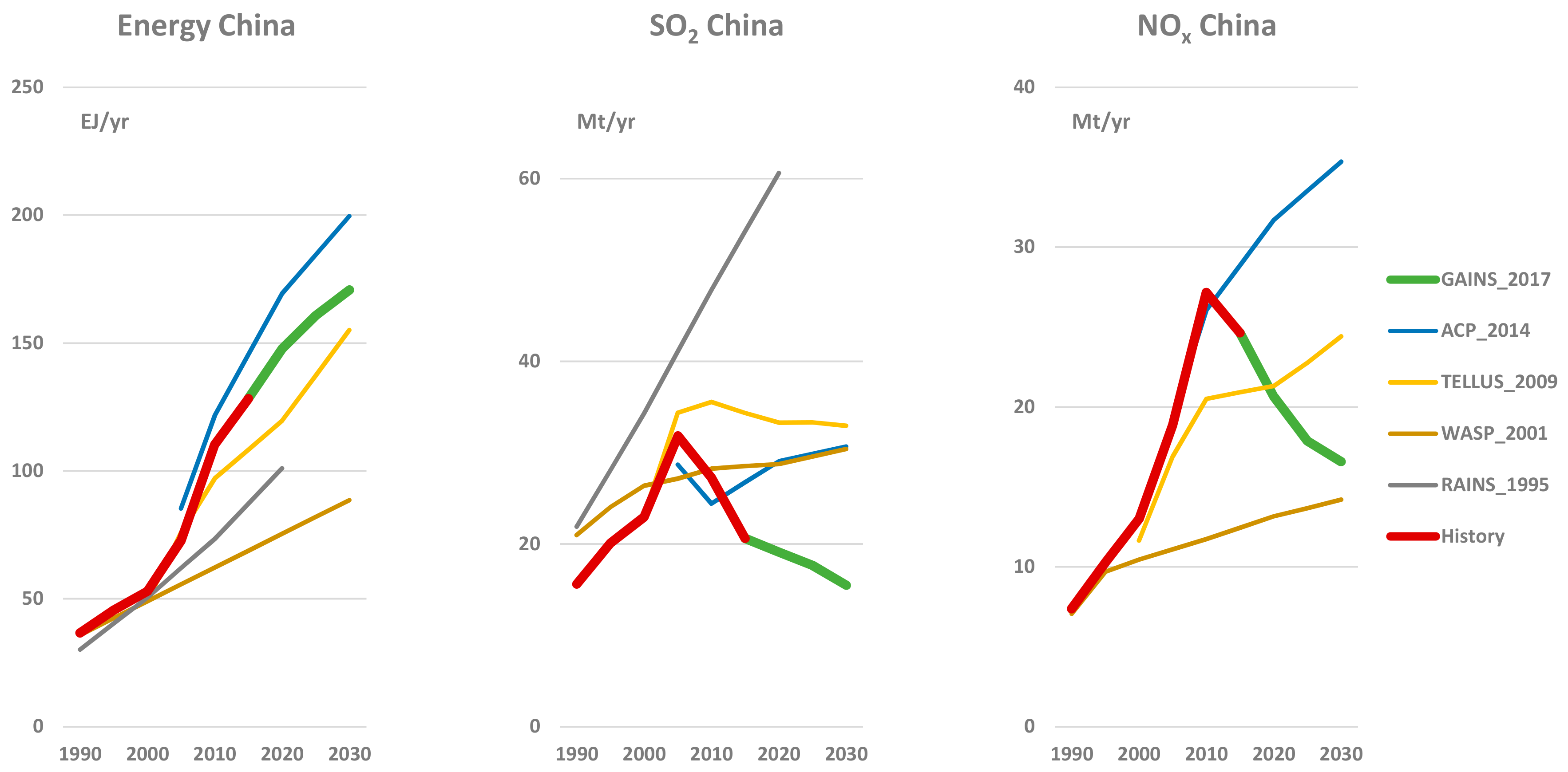

| Country | Policy | Revision | PM | SO2 | NOx |
|---|---|---|---|---|---|
| China | Emission standards for coal-fired power plants | 1992 | 200–3300 | ||
| 1996 | 200–3300 | 1200–2100 | 650–1000 | ||
| 2004 | 50–600 | 400–2100 | 450–1100 | ||
| 2012 | 20–30 | 50–400 | 100–200 | ||
| India | Environmental protection rules | 1986 | 150–350 | ||
| 2003 | 50–100 | ||||
| 2015 | 30–100 | 100–600 | 100–600 | ||
| Japan | Air pollution control law | 1968 | 600–2000 | ||
| 1996 | 50–200 | 410–720 | |||
| 1998 | 30–100 | 120–300 |
| Country | Policy | Revision | PM | NOx |
|---|---|---|---|---|
| China | Limits for emissions from light-duty vehicles | 2000 | 0.14–0.2 | 0.97–1.36 |
| 2004 | 0.08–0.1 | 0.5–0.9 | ||
| 2007 | 0.05 | 0.15–0.5 | ||
| 2010 | 0.025 | 0.08–0.25 | ||
| India | Bharat stages | 2000 | 0.14–0.25 | |
| 2005 | 0.08–0.17 | |||
| 2010 | 0.025–0.1 | 0.08–0.8 | ||
| Japan | Air pollution control law | 1978 | 0.25–0.9 | |
| Motor vehicle NOx law | 1992 | 0.25–0.48 | ||
| New short-term standards | 2001 | 0.014 | 0.05–0.15 | |
| Post new long-term emissions standards | 2009 | 0.005–0.007 | 0.05–0.11 |
© 2018 by the authors. Licensee MDPI, Basel, Switzerland. This article is an open access article distributed under the terms and conditions of the Creative Commons Attribution (CC BY) license (http://creativecommons.org/licenses/by/4.0/).
Share and Cite
Rafaj, P.; Amann, M. Decomposing Air Pollutant Emissions in Asia: Determinants and Projections. Energies 2018, 11, 1299. https://doi.org/10.3390/en11051299
Rafaj P, Amann M. Decomposing Air Pollutant Emissions in Asia: Determinants and Projections. Energies. 2018; 11(5):1299. https://doi.org/10.3390/en11051299
Chicago/Turabian StyleRafaj, Peter, and Markus Amann. 2018. "Decomposing Air Pollutant Emissions in Asia: Determinants and Projections" Energies 11, no. 5: 1299. https://doi.org/10.3390/en11051299



